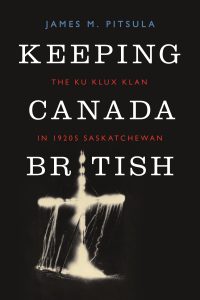Of all skeletons hidden in the nation’s attic, few are as strange as the Saskatchewan Klan. For a brief period in the 1920s the KKK thrived with rallies and cross-burnings. In no other province did Ku Kluxers achieve such prominence.
Yet the organization was never as influential as mythology suggests, nor as sadistic as its U.S. namesake. Historian James Pitsula does not document a single homicide attributed to the Saskatchewan Klan, where organizers seemed satisfied to wear idiot hoods and tell Catholic jokes.
“It held public meetings and sent out charismatic lecturers, almost in the style of evangelical preachers,” writes Prof. Pitsula, of the University of Regina. “It created drama and excitement with a hint of romance and danger.” The Klan’s Saskatchewan leader was a Regina accountant. Its members included the police chief in Melville, Sask., and MP Davy Cowan, a dentist who served two terms as Conservative member for Long Lake, Sask.
Keeping Canada British is an intriguing rummage through historical memory in which Pitsula invites readers to seek and find answers: who joined the Klan and why?
Actual membership in the Saskatchewan KKK from its founding in 1926 is disputed; the Regina Leader Post has published estimates from 10,000 to 45,000. “The Klan was known to exaggerate membership figures,” notes Pitsula. In 1927 when the KKK claimed 46,500 members in the province, Pitsula calculates it was closer to 4,700, possibly peaking at 20,000 or so by 1929.
Sociologists theorize that bigotry is driven by economic failure. Was it a coincidence the KKK’s rise in Saskatchewan came amid the collapse of the wheat boom? Pitsula does not mention the possibility, though the fact remains between 1919 and 1930 wheat prices fell from an average $2.37 a bushel to 44¢.
“It was a bottom-up, grassroots version of British Canadian nationalism that empowered lower middle-class and upper working-class individuals,” Pitsula explains. They were small-town Protestants who bristled at the waves of immigrants, more than 148,000 of them, who landed in Saskatchewan in the 1920s.
Klan sympathizers, he writes, “saw themselves as being on the losing side” of the postwar era. “They thought the war had been fought to keep Canada British, but now, in the postwar period, foreign immigrants were arriving in Saskatchewan in such numbers that the country was ceasing to be British.”
It was this very upheaval that kept the Klan in check. Cross-burning went only so far in a province that was 29 percent Catholic and Greek Orthodox.
Numerous researchers insist the Klan helped defeat Saskatchewan’s Liberal government in 1929, though here the evidence is uneven. Conservative Premier James Anderson was no race-baiter. No known Klansmen were elected to the legislature, though four Catholics were; and the era was hard on incumbents anyhow. Of all Canadian premiers in office in 1928 only two – Manitoba’s John Bracken and Quebec’s Louis-Alexandre Taschereau – remained in office five years later.
Regardless of embellishment, the saga of the Saskatchewan KKK remains an odd and disturbing curiosity. It is worth a trip to the attic.
By Holly Doan
Keeping Canada British: The Ku Klux Klan in 1920s Saskatchewan by James M. Pitsula; University of British Columbia Press; 308 pages; ISBN 9780-7748-24903; $32.95






